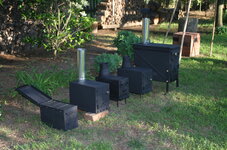indianajo
Well-Known Member
NBC News on 11/11/22 covered a NYC Public Service Announcement about E-bike & Scooter fires of LIthium Batteries.
There were the expected videos of burning apartments, a destroyed bike store, plus one scary video of a bike bursting into flame as a toddler ran away.
There were a list of recommendations including:
1 Watch the battery continuously while it is charging
2 Never replace a charger, use only the original charger that came with the bike or scooter
These are the most brain dead recommendations I can imagine. Watching a battery charge is right up there in productivity with watching the grass grow.
My battery has outlasted 3 chargers so far. NYC must really want to bury large quantities of functional batteries in their landfill. Chargers last ~100 - 200 cycles, except the ones that come with $5000 up bikes from manufacturers with enough assets to lose from lawsuits that they test their product and QA their battery & charger production thoroughly. Batteries last up to 1000 cycles.
My recommendations:
1 charge only outside, never indoors. Lock the battery to something that won't move.
2 Put the charger on a AC duration timer so the battery only charges to 100% monthly or quarterly. Alternate to that, buy a charger with 80% and 90% cutoff settings. Make sure the charger max voltage on the label is the one for your battery voltage. The 80%90%100% charger I bought from Luna for $70 arrived dead, I use $20 chargers from ebay, a timer from the home store, and a DVM to monitor the resulting voltage. Batteries that won't reach the expected voltage in the same time as new should not be further charged; they have a bad cell.
3 If you can't charge the battery outside, put the battery in a 3/8" thick 6 sides steel enclosure while charging. Ammo cans are not that thick. A gun safe is the only commercial product approaching this thickness, and they don't have a port for a charger cable.
4 Don't charge below freezing
5 Buy LiFePo4 batteries, not LiIon
6 If you can't afford 1 or 3, don't buy an e-bike or e-scooter.
There were the expected videos of burning apartments, a destroyed bike store, plus one scary video of a bike bursting into flame as a toddler ran away.
There were a list of recommendations including:
1 Watch the battery continuously while it is charging
2 Never replace a charger, use only the original charger that came with the bike or scooter
These are the most brain dead recommendations I can imagine. Watching a battery charge is right up there in productivity with watching the grass grow.
My battery has outlasted 3 chargers so far. NYC must really want to bury large quantities of functional batteries in their landfill. Chargers last ~100 - 200 cycles, except the ones that come with $5000 up bikes from manufacturers with enough assets to lose from lawsuits that they test their product and QA their battery & charger production thoroughly. Batteries last up to 1000 cycles.
My recommendations:
1 charge only outside, never indoors. Lock the battery to something that won't move.
2 Put the charger on a AC duration timer so the battery only charges to 100% monthly or quarterly. Alternate to that, buy a charger with 80% and 90% cutoff settings. Make sure the charger max voltage on the label is the one for your battery voltage. The 80%90%100% charger I bought from Luna for $70 arrived dead, I use $20 chargers from ebay, a timer from the home store, and a DVM to monitor the resulting voltage. Batteries that won't reach the expected voltage in the same time as new should not be further charged; they have a bad cell.
3 If you can't charge the battery outside, put the battery in a 3/8" thick 6 sides steel enclosure while charging. Ammo cans are not that thick. A gun safe is the only commercial product approaching this thickness, and they don't have a port for a charger cable.
4 Don't charge below freezing
5 Buy LiFePo4 batteries, not LiIon
6 If you can't afford 1 or 3, don't buy an e-bike or e-scooter.
Last edited:



